If you’ve ever felt discouraged by your inability to keep plants thriving, you’re not alone. Many people struggle with maintaining indoor greenery, but that doesn’t mean you have to give up on bringing a touch of nature into your home.
In this guide, we recommend 12 easy-to-tend plants for those with a “black thumb.” With these hardy, low-maintenance options, even novice gardeners can create stunning landscapes that thrive with minimal effort.
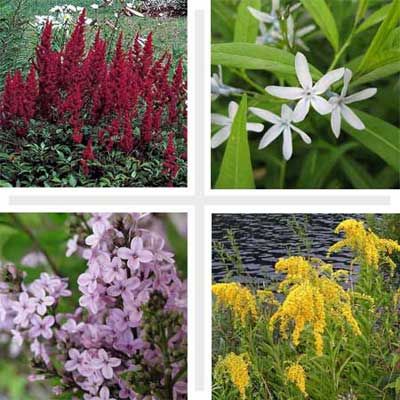
1. Hosta (Hadspen Blue)
Hostas, also known as plantain lilies, are a favorite among gardeners for their stunning foliage and ability to thrive in shady areas. These hardy plants come in many different sizes, colors, and leaf patterns, making them great for adding variety to any garden.
Hostas are relatively low-maintenance plants but can be susceptible to slug and snail damage. To deter these pests, scatter iron phosphate pellets around your plants or opt for naturally resistant varieties with heavily textured or waxy leaves. Some excellent choices include Blue Mouse Ears, First Frost, Krossa Regal, and Hadspen Blue.
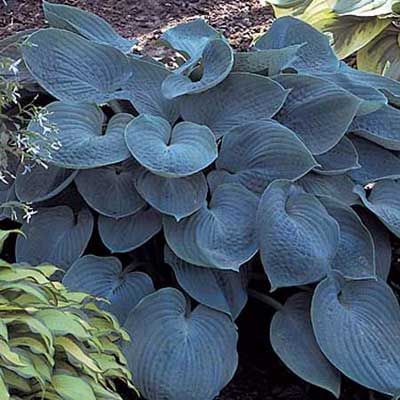
Depending on the variety, these hardy plants can grow from 3 inches to 5 feet across and up to 3 feet tall. They prefer partial to full shade and regular watering, making them ideal for darker corners of your garden that need a bit of life. For best results, plant them in well-drained soil to prevent root rot.
2. Astilbe (Ostrich Plume)
Astilbes are eye-catching perennials that produce feathery plumes of flowers in shades of white, pink, or red from late spring through summer. Even when not blooming, astilbes have attractive, divided leaves that effectively block light and help suppress weed growth. Two popular varieties are Ostrich Plume (also known as Straussenfeder), which features arching sprays of delicate pink flowers, and Astilbe x arendsii Fanal, known for its erect spikes of vibrant red blooms.
Most astilbe varieties grow 2–3 feet wide and around 3 feet tall, making them perfect for filling in medium-sized spaces in your garden. Though they thrive in partial shade, they can tolerate full sun in cooler climates. Regular watering is essential for these plants to flourish, so they’re ideal for gardeners who don’t mind a bit of consistent care. Make sure the soil stays moist, especially during dry spells, to help them maintain their lush appearance.
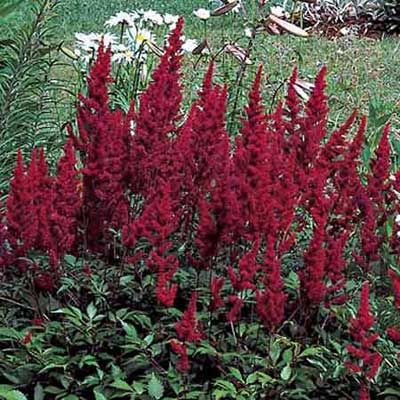
3. Hakone Grass (Hakonechloa macra)
Hakone grass is a beautiful ornamental grass that adds elegance and movement to any garden. Its graceful arching form resembles a miniature cascading bamboo, creating a soft, flowing effect that brightens shaded areas.
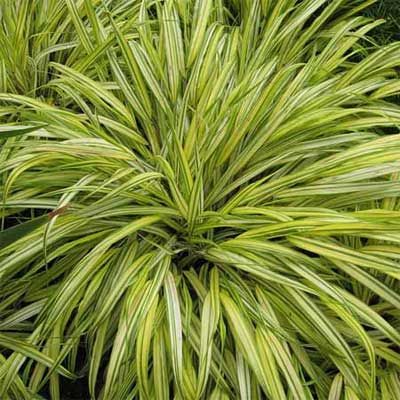
This versatile plant comes in several eye-catching varieties, each offering unique coloration:
- Aureola has golden leaves streaked with green, adding a vibrant contrast to garden spaces.
- All Gold features bright yellow leaves with a hint of green at the base for a subtle variation.
- Beni Kaze showcases a mix of red and green leaves, creating a dynamic and colorful effect throughout the seasons.
- Lemon Grass stands out with its striking lime-green foliage, bringing a fresh, bold look to any planting.
Hakone grass works well in borders or as a ground cover over wider areas. It grows to a manageable size of 12–18 inches tall and 18–24 inches wide, making it perfect for smaller gardens or as an accent plant in larger landscapes. This grass prefers moist, well-drained soil and can add a beautiful textural contrast when paired with other shade-loving plants like hostas or astilbes. It’s also deer-resistant, making it a safe choice for gardens prone to wildlife visits.
4. Common Lilac (Syringa vulgaris)
The common lilac (Syringa vulgaris), beloved for its hardy nature and intoxicating fragrance, is a classic garden favorite. These deciduous shrubs produce large clusters of flowers in shades of white, pink, or purple during mid to late spring, filling the air with their sweet scent.
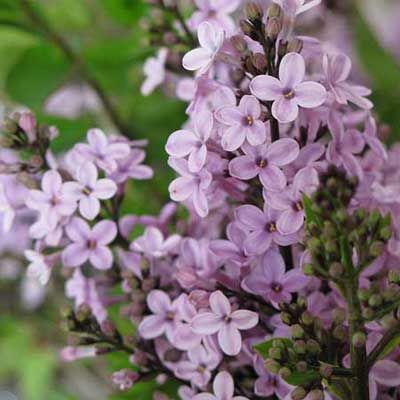
If you want to add a modern twist to this traditional plant, add one of these eye-catching varieties:
- Descanso hybrids: Ideal for mild-winter areas where standard lilacs may bloom sparsely
- French hybrids: Known for their especially showy flowers
- Sensation: Features striking purple petals edged in white
Common lilacs can reach 20 feet tall and wide, making them great for privacy screens or focal points in larger gardens. They thrive in full sun, tolerate partial shade in hot climates, and need regular watering, especially in their first growing season. Pruning after blooming encourages bushier growth and more flowers in the future.
5. Endless Summer Hydrangea (H. macrophylla)
The Endless Summer hydrangea provides the classic look of mophead hydrangeas without their finicky nature. This variety features fluffy clusters of flowers that can appear blue in acidic soil or pink in alkaline soil. Endless Summer can bloom on both new and old wood, making it much more forgiving than traditional hydrangeas.
The hydrangeas have a unique blooming habit that makes them resistant to early or late freezes. Even if the plant dies yearly, you’ll still get beautiful blooms on new growth. To enjoy repeat blooms into fall, deadhead spent flowers and add a slow-release fertilizer in spring.
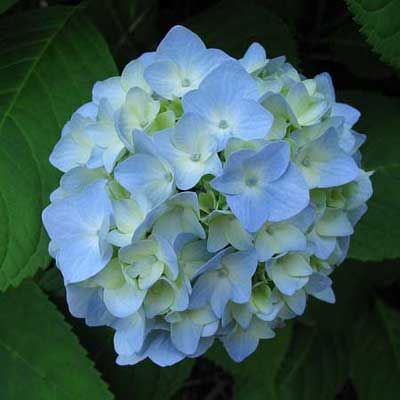
Endless Summer hydrangeas grow 3–5 feet tall and wide, making them perfect for medium-sized gardens or foundation plantings. They prefer partial shade and regular watering and thrive in zones 4–9. Good mulching practices can help retain soil moisture and regulate temperature, further aiding their growth.
6. Rugosa Rose (Rosa rugosa)
Rugosa roses are an excellent option for gardeners who desire the beauty of roses without the hassle. These exceptionally hardy, mostly pest-free roses are often called “sea tomatoes” because they can withstand salt spray along coastlines. Additionally, they produce red fruit, known as “hips,” that look like cherry tomatoes.
Rugosa roses come in various flower forms and colors including single or double blossoms in white, yellow, pink, purple, or red. Some popular varieties include Frau Dagmar Hartrpp, known for its single pink flowers, Hansa with double magenta blooms, and Roseraie de l’Hay with purplish-rose flowers.
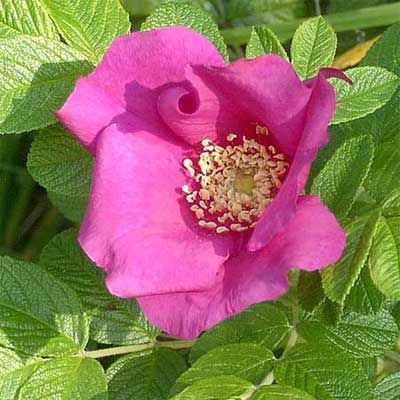
These roses can grow 3–6 feet tall and wide and are great for hedges or standalone plants. Once established, they like full sun and can tolerate dry soil, although they thrive in moist soil. The stems of rugosa roses have sharp thorns, making them a good natural barrier for creating a hedge that keeps people out. They bloom from late spring to early summer and smell great during this time.
7. False Indigo (Baptisia)
False indigo, a plant native to the Eastern and Southern United States, is beautiful and resilient in gardens. In the spring, it produces lovely spikes of blue or white flowers on upright stems. Once the flowers fade, long seedpods form and turn black when ripe, lasting through the winter. These seedpods can be used in dried flower arrangements to add interest to your garden during the colder months. Blue false indigo (B. australis) is a popular variety that grows 3–6 feet tall and 4 feet wide. Another favorite, White false indigo (B. alba), is more compact, reaching 2–3 feet tall and 3 feet wide.
False indigo prefers full sun, and while it appreciates moderate water, it becomes drought-tolerant once established. This makes it an excellent choice for low-maintenance gardens or areas prone to dry spells. Its deep root system also makes it resistant to rabbit and deer browsing, making it suited for rural or suburban areas. Regularly applying mulch can aid in maintaining soil moisture during particularly dry spells.
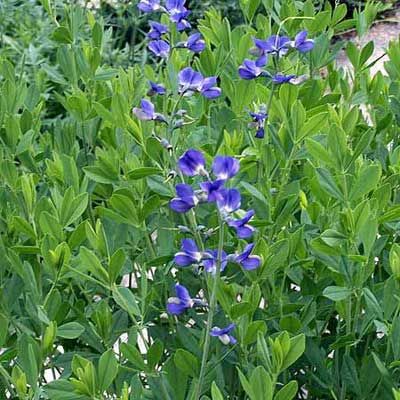
8. New Zealand Flax (Phormium tenax)
New Zealand flax is a remarkable and low-maintenance plant that brings a dramatic architectural touch to any garden. While it does produce red flowers on tall stalks in summer, this plant is mainly cultivated for its large, sword-shaped leaves. These leaves often come in stunning color combinations, with streaks of cream, bronze, purple, or rose against a green background.
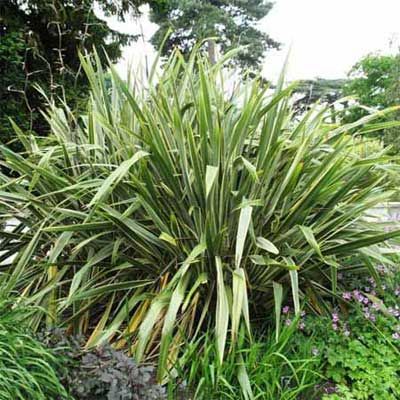
Some popular varieties of New Zealand flax include:
- Atropurpureum: Boasts deep purple leaves
- Sundowner: Features bronze-green leaves with pink margins
- Yellow Wave: Offers bright yellow and green striped foliage
New Zealand flax can grow between 1–6 feet tall and 1–3 feet wide, depending on the variety. There are smaller container-sized plants available for those with limited space. This versatile plant prefers full sun to partial shade and can tolerate various water conditions, from little to regular watering. While it is perennial in zones 9–11, it will usually regrow from the roots if it dies in zones 7 and 8, making it a potential option for gardeners in slightly cooler climates. For optimal growth, plant them in well-drained soil to prevent root rot.
9. Penstamon (P. digitalis)
Penstemon, often called beardtongue due to its pronounced “tongue” on its narrow, bell-shaped flowers, is a versatile, low-maintenance plant that adds vertical interest and color to any garden. The popular Husker Red variety features maroon leaves and light pink flowers, while Dark Towers offers an even more robust and brilliantly colored option.
Some key features of penstemon include its drought tolerance once established, making it suitable for low-water gardens. Its vibrant flowers attract pollinators such as hummingbirds and butterflies. Penstemon also has a long blooming period, spanning from late spring to early fall, providing extended color in the garden.

Husker Red and Dark Towers grow 2 1/2 –3 feet tall, but other varieties can reach up to 5 feet in height. Penstemon prefers full sun but can tolerate light shade, making it adaptable to various garden locations. Regular watering helps establish the plant, but once it is mature, it can withstand periods of drought. For best results, deadhead spent blooms to encourage continuous flowering and maintain a neat appearance.
10. Spirea
Spirea is an easy-to-grow deciduous shrub that comes in two basic forms, offering versatility for different garden styles and needs: The Bridal wreath features cascading branches covered with clusters of white flowers. Erect shrubs produce red, pink, or white flowers on more upright stems.
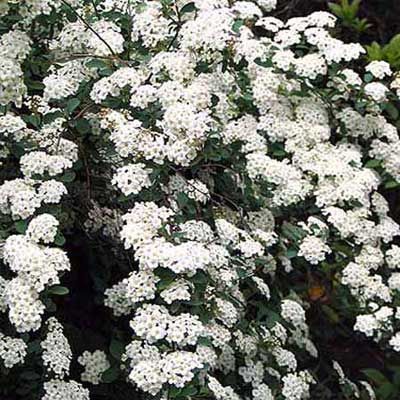
Some popular varieties of spirea include:
- S. cantoninsis Flore-Pleno: A bridal wreath type with double white flowers
- S. trilobata Fairy Queen: An erect form with white flowers
- S. densiflora (mountain spirea): A Western native with pink blossoms
Spirea shrubs vary in size, from 1–7 feet tall and up to 10 feet across. They can be used for hedges or as focal points, prefer full sun to light shade, and can adapt to different watering conditions. Prune them after flowering to encourage fresh growth and extended blooming.
11. Bluestar
Bluestar is a resilient, indigenous plant that adds a touch of delicate beauty to the garden. Originating from the Southeast United States, this plant showcases slender leaves adorned with clusters of small, star-shaped blue flowers.
Two popular varieties of Bluestar are Hubricht’s Bluestar (Amsonia hubrichtii) and A. tabernaemontana. Hubricht’s Bluestar, also known as threadleaf bluestar, is distinguished by its soft, needlelike leaves and produces sky-blue flowers. This variety offers multi-season interest as it turns bright gold in the fall. In contrast, A. tabernaemontana features steel blue to lavender-blue flowers and has broader leaves compared to its threadleaf cousin.
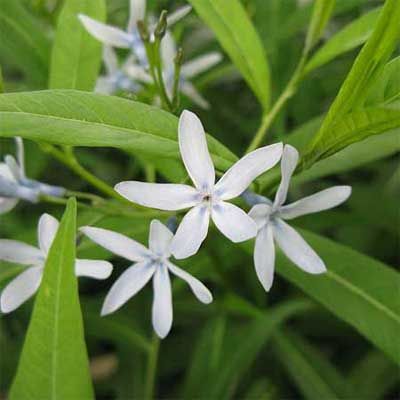
Bluestar typically grows 2–3 feet high and is a great middle-ground plant. It prefers full sun to light shade, can tolerate regular to moderate watering, and is drought-tolerant once established. It’s also resistant to deer and rabbit browsing and attracts pollinators, making it a valuable addition to gardens.
12. Goldenrod (Solidago)
Goldenrod is a stunning late-season flower that adds a vibrant golden color to the garden as summer comes to a close. It’s important to note that goldenrod is not the cause of hay fever allergies. The true culprit is ragweed, which blooms at the same time.
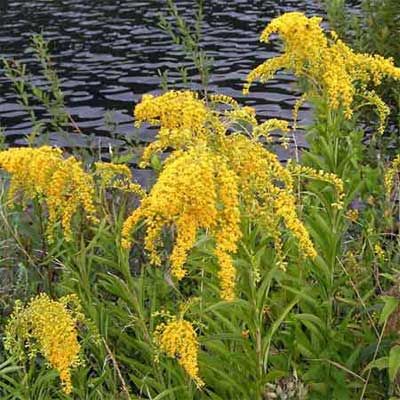
Here are some notable varieties of goldenrod:
- Goldenmosa: A Solidago hybrid that produces erect bouquets of golden blooms.
- S. gigantea (giant goldenrod): An impressive variety that can tower up to 7 feet tall.
- S. rugosa Fireworks: This variety features arching wands covered with bright yellow flowers, resembling sparkling firework trails.
Goldenrods grow 1 1/2–3 feet tall and 2 feet wide and are suitable for gardens. They prefer full sun to light shade, require moderate watering, and attract beneficial pollinators. Divide clumps every few years to control invasiveness.
